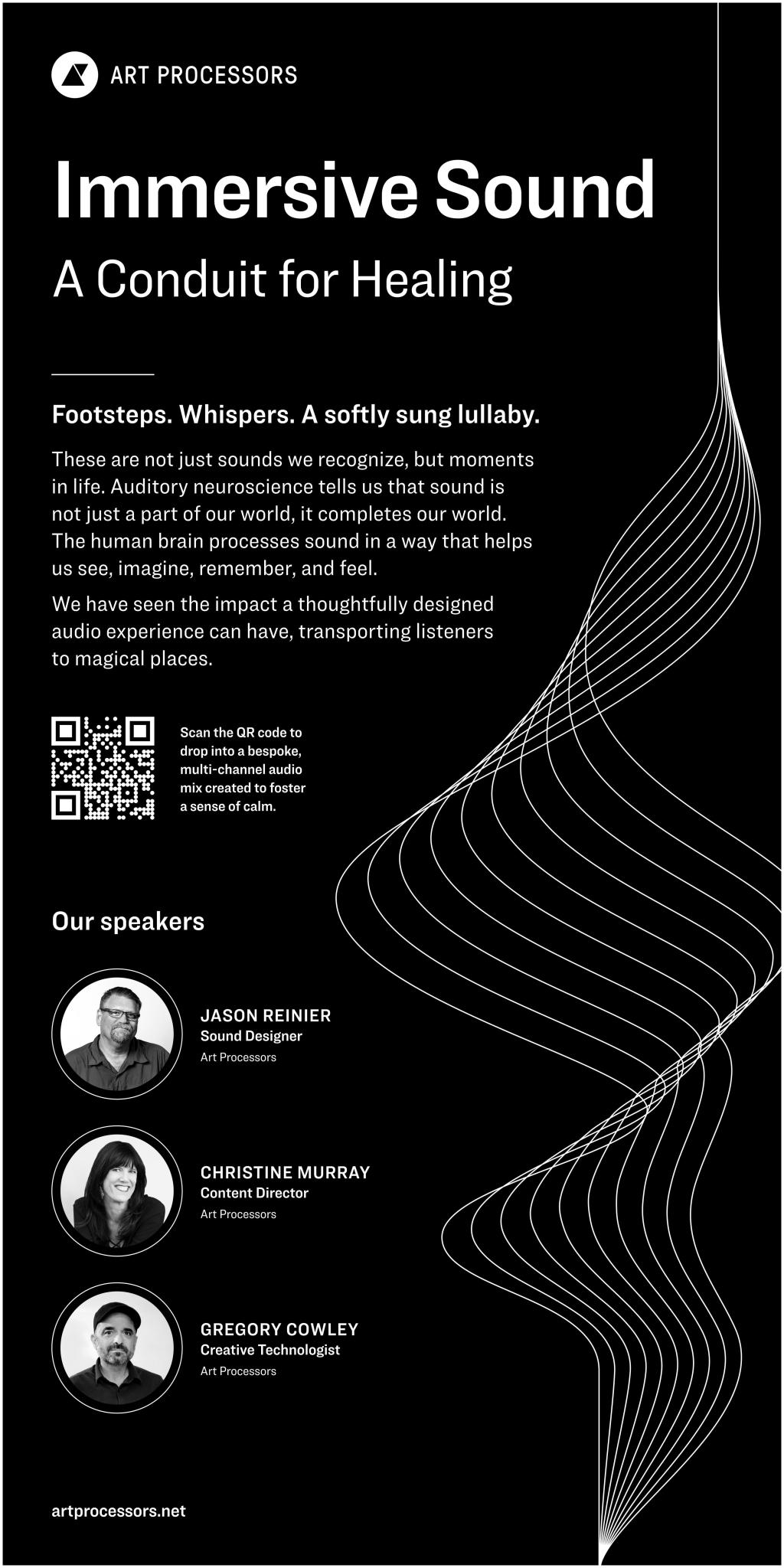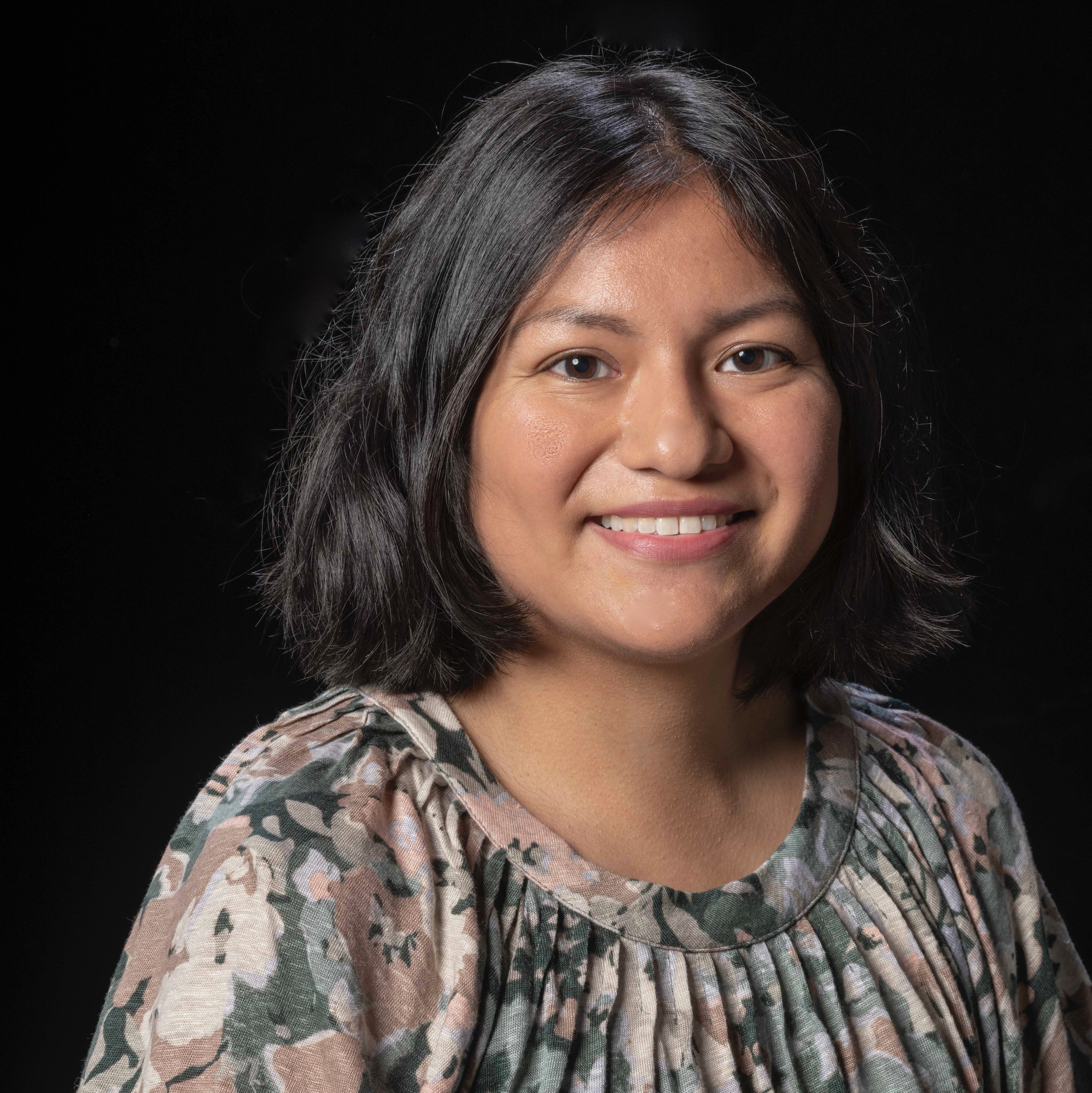
Sound is a potent force. When harnessed with intention and care, its impact can be substantial. As a trained ethnomusicologist with experience working in museums like the Louis Armstrong House Museum, I have long been fascinated with the application of curated sound in exhibition spaces and how it can impact visitors.
Motivated by these interests, I arranged to meet with three people presenting at the 2022 AAM Annual Meeting & MuseumExpo whose work involves thoughtful manipulation of sound. Greg Cowley, Christine Murray, and Jason Reinier—the Creative Technologist, Content Director, and Sound Designer of the experiential design and technology company Art Processors—delivered a poster presentation and talk entitled “Immersive Sound: A Conduit for Healing and Deeper Interpretation.” Their talk invited attendees to listen to quotidian recorded and live sounds and ponder the ways they can activate emotions, memories, bodies, and the senses. Meanwhile, their poster provided a QR code that revealed a virtual listening tree, designed to help attendees feel a sense of calm and well-being.
I spoke with them about the significance of their poster presentation, the power of immersive sound and listening in museums, creating accessible and inclusive sensorial museum projects, and how the pandemic affected the way they think about and carry out their work for clients. Their words shed light on why immersive sound matters in exhibitions and reveal a humane way to contemplate and incorporate sound-related technologies in museums.
Maglyn Bertrand: From learning more about Art Processors, it seems the company does offer a range of services. Why did you decide to make immersive sound the focus of the AAM poster and talk?
Christine Murray: We’re experience designers. What we are after in our work, no matter what, is connecting humans to moments of wonder that happen in cultural institutions and museums. Sound is such a deep way to connect to emotion beyond language.
One thing that sound can do is stop time and make you deeply present in the moment. And with everyone talking right now about healing and well-being, I think our opportunity to do that is to give them a sense of connection and understanding of “we’re all in this together.” This idea of being fully immersed in something is a very different experience than what is happening to us right now, which is that so much information is coming at us in bits and pieces all the time and a lot of people are just overwhelmed by that. There is something about immersive sound: You are going on a journey that is curated, which can knock out a lot of noise and commotion to give you just one sense of being. That’s why I think we do what we do.
Greg Cowley: Sound is ever-present. Every museum, every aspect of our lives has sound present whether we choose to address it or use it or not, so even a quiet museum space is going to have voices and sounds of footsteps. So, we have an opportunity to use that for museums, to use that as something that can add to the experience.

Bertrand: How would you describe the immersive sound experience that Art Processors provides?
Jason Reinier: Sound is not a primary component of most design spaces, and a lot is paid attention to visually. So, one of the goals that I have as a sound person is to bring sound more on the level with other ingredients, so when we talk about immersion, we are talking about the entire space and how it feels to move through it. What do you want to have people walk into? What do you want to have people walk out of, and how does that work with their experience? And we’re designing that space, so we are talking about how we can create a space for human beings to feel a real context and a sense of purpose, meaning, and educational value.
Murray: I come from an audio production background and often sound and storytelling through sound is the last thing that exhibition designers consider. It sort of gets tacked on, so it is not a holistic approach where everything is working together to create one unified experience. That is what Art Processors does. Sound is as important in the whole as everything else and it is not something that gets tacked on or thought of as a last-minute solution. That is how it is immersive, in my opinion. You cannot separate it from anything else that is going on. It is intricately woven like a tapestry.
Bertrand: What do you think of the traditional “audio tour,” and how do you think that Art Processors is offering something that gives visitors a different experience?
Reinier: There is one tour that I experienced on a visit to Australia that blew my mind: Japan Supernatural at the Art Gallery of New South Wales in Sydney. What was special was the mobile experience. The tour was delivered on a platform that Art Processors has been developing, and it created an experience that was elegant and spatial. It offered solutions to choosing whether you want to hear a voice or just hear sound. The soundscape that you were in was immersive, a completely enveloped experience that had objects and specific sounds at various locations. So, you would walk in front of an artwork, and you would be introduced to a spatially specific soundscape. And you could listen to a voiceover or a story or you could move through the soundscape. Those are the kinds of things that as a sound designer are transparent technically but beautiful as an experience.
Murray: We’re quite experts in this field of location-aware sound, where sound arrives where you are in the moment that you need it to create an experience in that place. And we have this platform that makes that happen, and often it delivers an experience to someone before they even know they want it. It is very intuitive.
Cowley: This comes back to the idea of technology being invisible. The audio is appropriate, and it is precise, and it is aware of where you are and it’s delivering the audio that you need or want to understand what you are looking at. So, it is different from an audio tour where the audio is telling you what to do. It is more like the audio is responding to what you decide to do, and so you are the master of your own experience.
Murray: In this holistic design practice that we have, we pay a lot of attention to the journey through a space and where the emotional moments are and where the cognitive moments are, and the kind of choreography between the two. Sometimes the cognitive, more intellectual information leads you to an emotional place, and sometimes it is the other way around. But sound is the thing that attaches to emotion. It connects to emotion in a way that nothing else does. And so, we are often making storytelling arcs where we are mapping the ratio between the cognitive and emotional. That is another way that we approach audio differently.
Art Processors created the Japan Supernatural Audio Experience for the Art Gallery of New South Wales.
Bertrand: I want to ask about sound in relation to accessibility. Not everyone may feel included in exhibitions that feature immersive sound or that offer sensorial experiences created by technologies. So, how has Art Processors tried to make its museum projects accessible to as many people as possible, such as those who are deaf or hard of hearing or are novice technology users?
Murray: Accessibility is a huge part of our practice. We’re super versed in using all the kinds of accessible options that are already available and embedded in a lot of different kinds of technologies.
Everything that we do has open or closed captions. We have a lot of experience making ASL and Auslan—Australian sign language—videos and interactives. We have a deep relationship with an accessibility partner that reviews our work and consults with us, which helps us develop the most inclusive programs. And this location-awareness thing—this is more applicable to blind and low-vision visitors, but this idea that things can arrive to you without your needing to see or interact, but can give you haptic feedback, sonified wayfinding, gallery overviews, that kind of thing is also a big part of the way that we design our mobile experiences.
Cowley: The haptic and the low frequency and the aspects of sound that can be felt physically for someone that is hard of hearing or without hearing, is in our toolkit. We can work with that and offer that.
Reinier: I’ve done audio tours where the ASL was integrated into the content, so we had an ASL curator working to create a stop that was not just available for the Deaf community, but also was featured so that anybody could follow both the signing and the content, and it was really fun. I would also like to say I have worked with Deaf collaborators who are cool with sound. They totally get it. I was doing a recording, a soundscape with a Deaf video artist and we were working on creating detailed sound. She was able to visualize sound. She knew what she wanted, and she was able to communicate it and make sound. We have to define what deaf is by listening to what Deaf people want.
Bertrand: I am curious to hear your thoughts on how the pandemic has altered your thinking about managing, designing, and implementing various projects for museums.
Cowley: People have had a lot of experiences taken away during the pandemic, and there is a hunger for things that are more experiential as a result of the pandemic. So that for us is great because that is a larger audience, more interest for something that we were already doing.
Reinier: The other thing is that we’re a remote company that deals with Zoom, Google, and everything remote. I have been working with Australia and doing very complicated interactive projects, even though I’m based in San Francisco. I’ve never been able to go on site. That created a vocabulary of solutions that now are fulfilling a need that we have had anyway. The pandemic just put a hyper-drive on it. Now, there are ways of communicating, ways of collaborating, and ways of sharing that are all immersive in themselves. What I hope we are able to do in the next iteration of this is to create an immersive prototype space that can be shared across the globe, so that we can be in San Francisco and we can share it experientially with our clients and colleagues.
Murray: When I think about the pandemic, and I think about our work and museum practice, I think like Greg was saying, there is a hunger for people to have experiences, because we have all been isolated from one another, and we’re all so saturated with this two-dimensional digital thing. I think that people are hungry for museums to be a place of healing and catharsis. I really think that’s what museums can do in the post-pandemic period: offer a space for us to be together and reconnect with the deepest universal human experiences that are out there. That is what I think about when I think about our practice and how we can be a part of making that happen for people.
This interview has been edited and condensed.








